HS450 Unit 3 Assignment: Change Management Theories and EHR Systems
VerifiedAdded on 2023/06/03
|10
|2091
|300
Report
AI Summary
This paper critically analyzes change management theories, leadership styles, and techniques in the context of implementing a new Electronic Health Records (EHR) system within a health organization. It evaluates the transition to EHR, highlighting the need for management interventions and addressing challenges such as cultural complacency, resistance to change, and communication gaps. The report discusses Kotter’s theory of change management and Rogers’ theory of innovation diffusion, proposing a merged approach for effective EHR implementation. It emphasizes the importance of stakeholder engagement, effective communication, and strong leadership to overcome barriers and ensure successful adoption of EHR. The paper also touches on the need for proper procurement management to support the implementation process. Desklib provides access to similar solved assignments and resources for students.
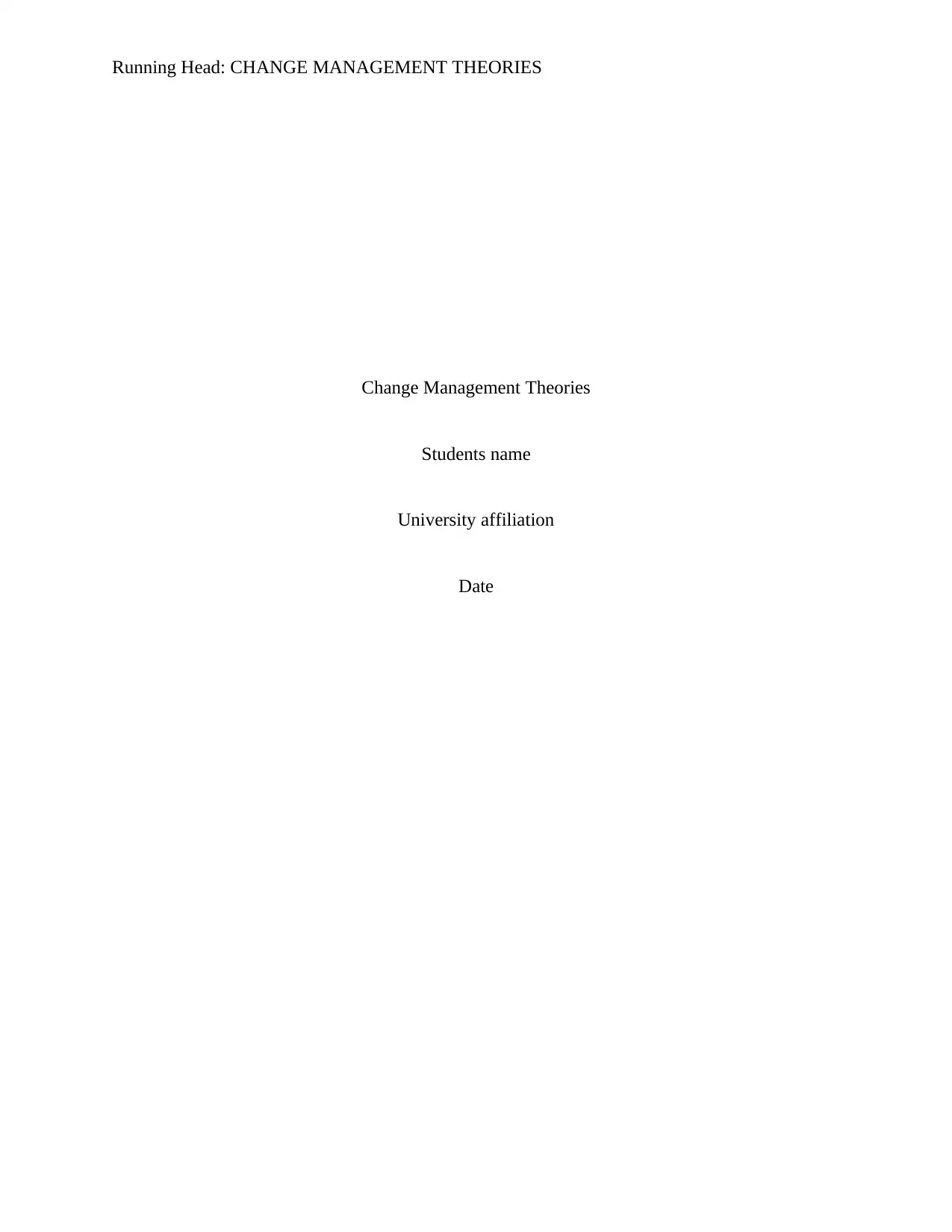
Running Head: CHANGE MANAGEMENT THEORIES
Change Management Theories
Students name
University affiliation
Date
Change Management Theories
Students name
University affiliation
Date
Paraphrase This Document
Need a fresh take? Get an instant paraphrase of this document with our AI Paraphraser
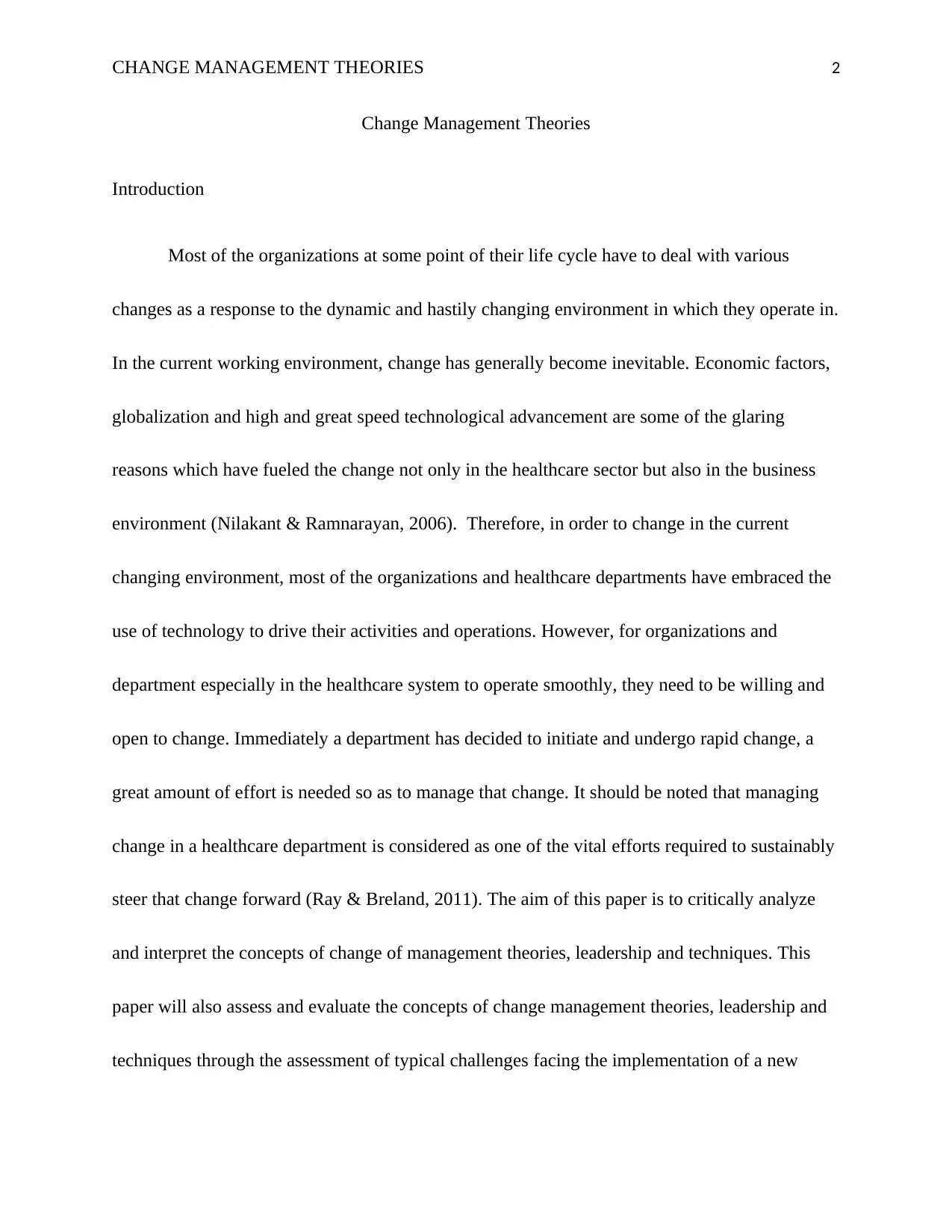
CHANGE MANAGEMENT THEORIES 2
Change Management Theories
Introduction
Most of the organizations at some point of their life cycle have to deal with various
changes as a response to the dynamic and hastily changing environment in which they operate in.
In the current working environment, change has generally become inevitable. Economic factors,
globalization and high and great speed technological advancement are some of the glaring
reasons which have fueled the change not only in the healthcare sector but also in the business
environment (Nilakant & Ramnarayan, 2006). Therefore, in order to change in the current
changing environment, most of the organizations and healthcare departments have embraced the
use of technology to drive their activities and operations. However, for organizations and
department especially in the healthcare system to operate smoothly, they need to be willing and
open to change. Immediately a department has decided to initiate and undergo rapid change, a
great amount of effort is needed so as to manage that change. It should be noted that managing
change in a healthcare department is considered as one of the vital efforts required to sustainably
steer that change forward (Ray & Breland, 2011). The aim of this paper is to critically analyze
and interpret the concepts of change of management theories, leadership and techniques. This
paper will also assess and evaluate the concepts of change management theories, leadership and
techniques through the assessment of typical challenges facing the implementation of a new
Change Management Theories
Introduction
Most of the organizations at some point of their life cycle have to deal with various
changes as a response to the dynamic and hastily changing environment in which they operate in.
In the current working environment, change has generally become inevitable. Economic factors,
globalization and high and great speed technological advancement are some of the glaring
reasons which have fueled the change not only in the healthcare sector but also in the business
environment (Nilakant & Ramnarayan, 2006). Therefore, in order to change in the current
changing environment, most of the organizations and healthcare departments have embraced the
use of technology to drive their activities and operations. However, for organizations and
department especially in the healthcare system to operate smoothly, they need to be willing and
open to change. Immediately a department has decided to initiate and undergo rapid change, a
great amount of effort is needed so as to manage that change. It should be noted that managing
change in a healthcare department is considered as one of the vital efforts required to sustainably
steer that change forward (Ray & Breland, 2011). The aim of this paper is to critically analyze
and interpret the concepts of change of management theories, leadership and techniques. This
paper will also assess and evaluate the concepts of change management theories, leadership and
techniques through the assessment of typical challenges facing the implementation of a new
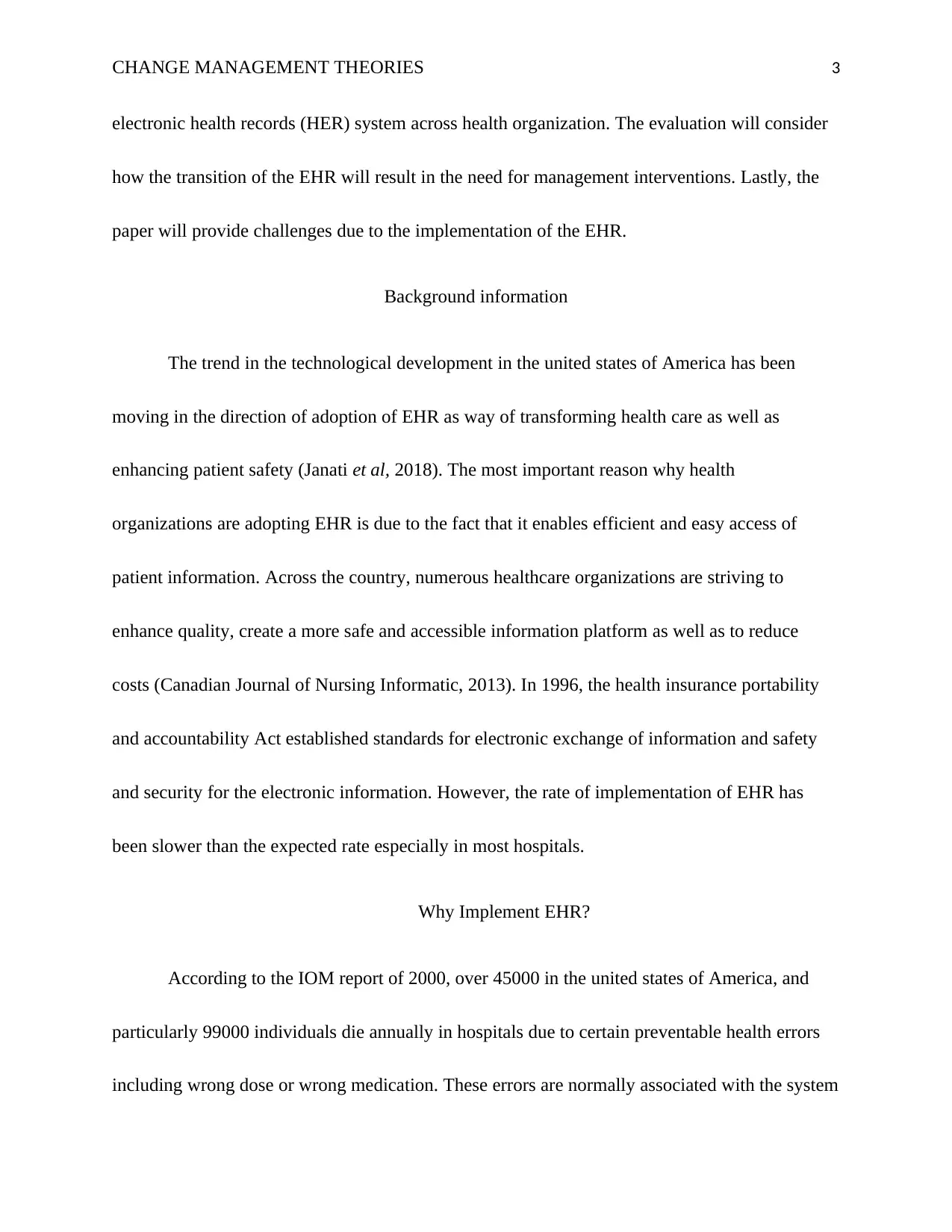
CHANGE MANAGEMENT THEORIES 3
electronic health records (HER) system across health organization. The evaluation will consider
how the transition of the EHR will result in the need for management interventions. Lastly, the
paper will provide challenges due to the implementation of the EHR.
Background information
The trend in the technological development in the united states of America has been
moving in the direction of adoption of EHR as way of transforming health care as well as
enhancing patient safety (Janati et al, 2018). The most important reason why health
organizations are adopting EHR is due to the fact that it enables efficient and easy access of
patient information. Across the country, numerous healthcare organizations are striving to
enhance quality, create a more safe and accessible information platform as well as to reduce
costs (Canadian Journal of Nursing Informatic, 2013). In 1996, the health insurance portability
and accountability Act established standards for electronic exchange of information and safety
and security for the electronic information. However, the rate of implementation of EHR has
been slower than the expected rate especially in most hospitals.
Why Implement EHR?
According to the IOM report of 2000, over 45000 in the united states of America, and
particularly 99000 individuals die annually in hospitals due to certain preventable health errors
including wrong dose or wrong medication. These errors are normally associated with the system
electronic health records (HER) system across health organization. The evaluation will consider
how the transition of the EHR will result in the need for management interventions. Lastly, the
paper will provide challenges due to the implementation of the EHR.
Background information
The trend in the technological development in the united states of America has been
moving in the direction of adoption of EHR as way of transforming health care as well as
enhancing patient safety (Janati et al, 2018). The most important reason why health
organizations are adopting EHR is due to the fact that it enables efficient and easy access of
patient information. Across the country, numerous healthcare organizations are striving to
enhance quality, create a more safe and accessible information platform as well as to reduce
costs (Canadian Journal of Nursing Informatic, 2013). In 1996, the health insurance portability
and accountability Act established standards for electronic exchange of information and safety
and security for the electronic information. However, the rate of implementation of EHR has
been slower than the expected rate especially in most hospitals.
Why Implement EHR?
According to the IOM report of 2000, over 45000 in the united states of America, and
particularly 99000 individuals die annually in hospitals due to certain preventable health errors
including wrong dose or wrong medication. These errors are normally associated with the system
⊘ This is a preview!⊘
Do you want full access?
Subscribe today to unlock all pages.

Trusted by 1+ million students worldwide
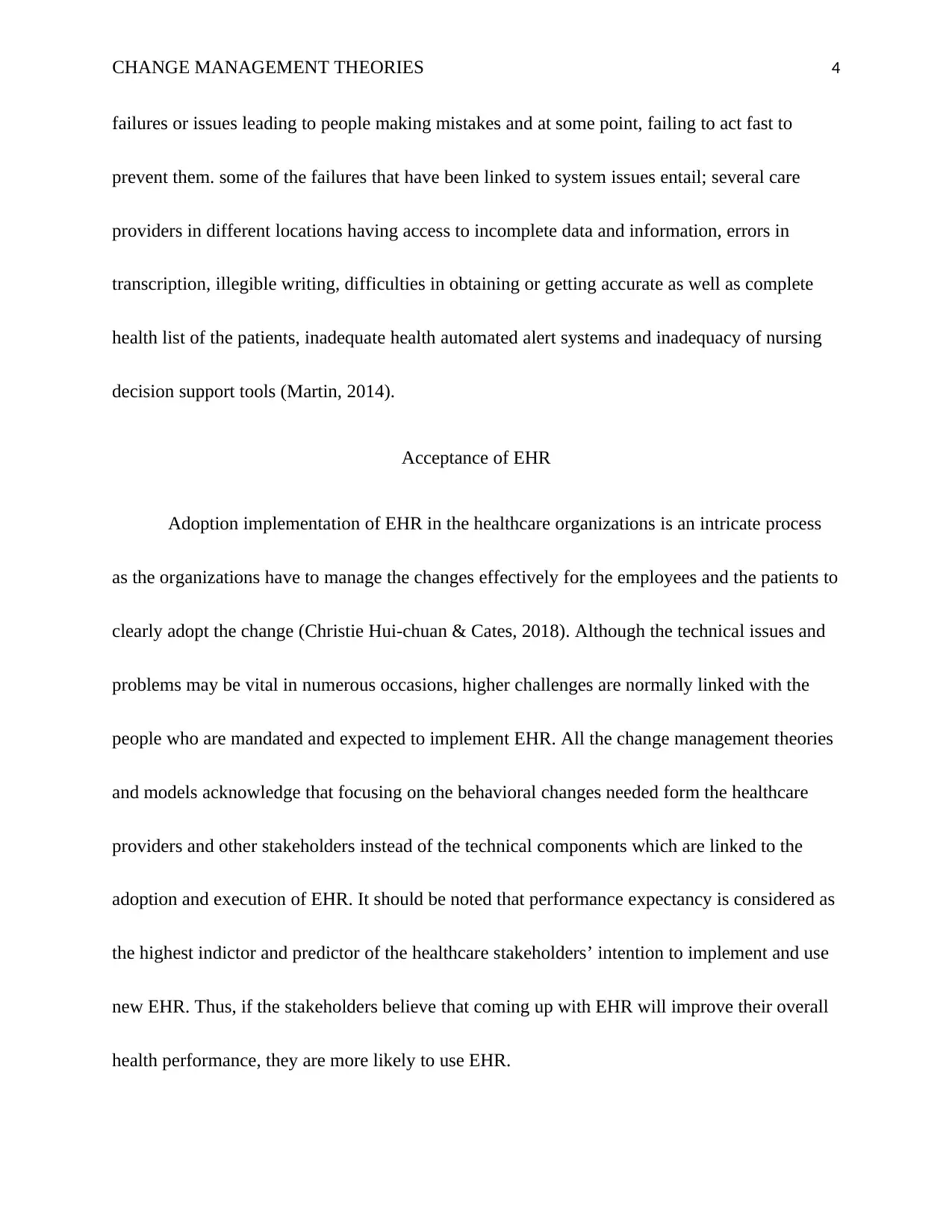
CHANGE MANAGEMENT THEORIES 4
failures or issues leading to people making mistakes and at some point, failing to act fast to
prevent them. some of the failures that have been linked to system issues entail; several care
providers in different locations having access to incomplete data and information, errors in
transcription, illegible writing, difficulties in obtaining or getting accurate as well as complete
health list of the patients, inadequate health automated alert systems and inadequacy of nursing
decision support tools (Martin, 2014).
Acceptance of EHR
Adoption implementation of EHR in the healthcare organizations is an intricate process
as the organizations have to manage the changes effectively for the employees and the patients to
clearly adopt the change (Christie Hui-chuan & Cates, 2018). Although the technical issues and
problems may be vital in numerous occasions, higher challenges are normally linked with the
people who are mandated and expected to implement EHR. All the change management theories
and models acknowledge that focusing on the behavioral changes needed form the healthcare
providers and other stakeholders instead of the technical components which are linked to the
adoption and execution of EHR. It should be noted that performance expectancy is considered as
the highest indictor and predictor of the healthcare stakeholders’ intention to implement and use
new EHR. Thus, if the stakeholders believe that coming up with EHR will improve their overall
health performance, they are more likely to use EHR.
failures or issues leading to people making mistakes and at some point, failing to act fast to
prevent them. some of the failures that have been linked to system issues entail; several care
providers in different locations having access to incomplete data and information, errors in
transcription, illegible writing, difficulties in obtaining or getting accurate as well as complete
health list of the patients, inadequate health automated alert systems and inadequacy of nursing
decision support tools (Martin, 2014).
Acceptance of EHR
Adoption implementation of EHR in the healthcare organizations is an intricate process
as the organizations have to manage the changes effectively for the employees and the patients to
clearly adopt the change (Christie Hui-chuan & Cates, 2018). Although the technical issues and
problems may be vital in numerous occasions, higher challenges are normally linked with the
people who are mandated and expected to implement EHR. All the change management theories
and models acknowledge that focusing on the behavioral changes needed form the healthcare
providers and other stakeholders instead of the technical components which are linked to the
adoption and execution of EHR. It should be noted that performance expectancy is considered as
the highest indictor and predictor of the healthcare stakeholders’ intention to implement and use
new EHR. Thus, if the stakeholders believe that coming up with EHR will improve their overall
health performance, they are more likely to use EHR.
Paraphrase This Document
Need a fresh take? Get an instant paraphrase of this document with our AI Paraphraser
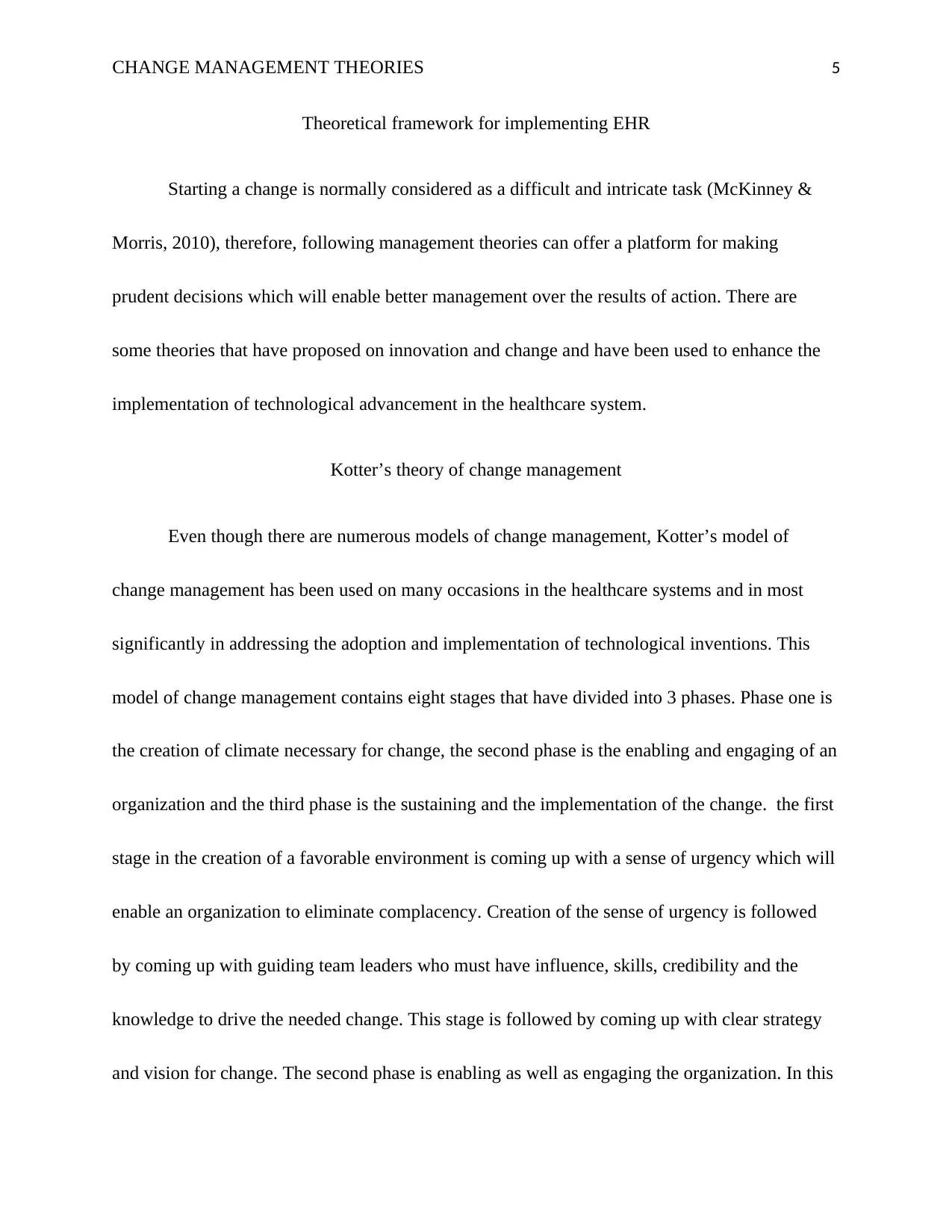
CHANGE MANAGEMENT THEORIES 5
Theoretical framework for implementing EHR
Starting a change is normally considered as a difficult and intricate task (McKinney &
Morris, 2010), therefore, following management theories can offer a platform for making
prudent decisions which will enable better management over the results of action. There are
some theories that have proposed on innovation and change and have been used to enhance the
implementation of technological advancement in the healthcare system.
Kotter’s theory of change management
Even though there are numerous models of change management, Kotter’s model of
change management has been used on many occasions in the healthcare systems and in most
significantly in addressing the adoption and implementation of technological inventions. This
model of change management contains eight stages that have divided into 3 phases. Phase one is
the creation of climate necessary for change, the second phase is the enabling and engaging of an
organization and the third phase is the sustaining and the implementation of the change. the first
stage in the creation of a favorable environment is coming up with a sense of urgency which will
enable an organization to eliminate complacency. Creation of the sense of urgency is followed
by coming up with guiding team leaders who must have influence, skills, credibility and the
knowledge to drive the needed change. This stage is followed by coming up with clear strategy
and vision for change. The second phase is enabling as well as engaging the organization. In this
Theoretical framework for implementing EHR
Starting a change is normally considered as a difficult and intricate task (McKinney &
Morris, 2010), therefore, following management theories can offer a platform for making
prudent decisions which will enable better management over the results of action. There are
some theories that have proposed on innovation and change and have been used to enhance the
implementation of technological advancement in the healthcare system.
Kotter’s theory of change management
Even though there are numerous models of change management, Kotter’s model of
change management has been used on many occasions in the healthcare systems and in most
significantly in addressing the adoption and implementation of technological inventions. This
model of change management contains eight stages that have divided into 3 phases. Phase one is
the creation of climate necessary for change, the second phase is the enabling and engaging of an
organization and the third phase is the sustaining and the implementation of the change. the first
stage in the creation of a favorable environment is coming up with a sense of urgency which will
enable an organization to eliminate complacency. Creation of the sense of urgency is followed
by coming up with guiding team leaders who must have influence, skills, credibility and the
knowledge to drive the needed change. This stage is followed by coming up with clear strategy
and vision for change. The second phase is enabling as well as engaging the organization. In this
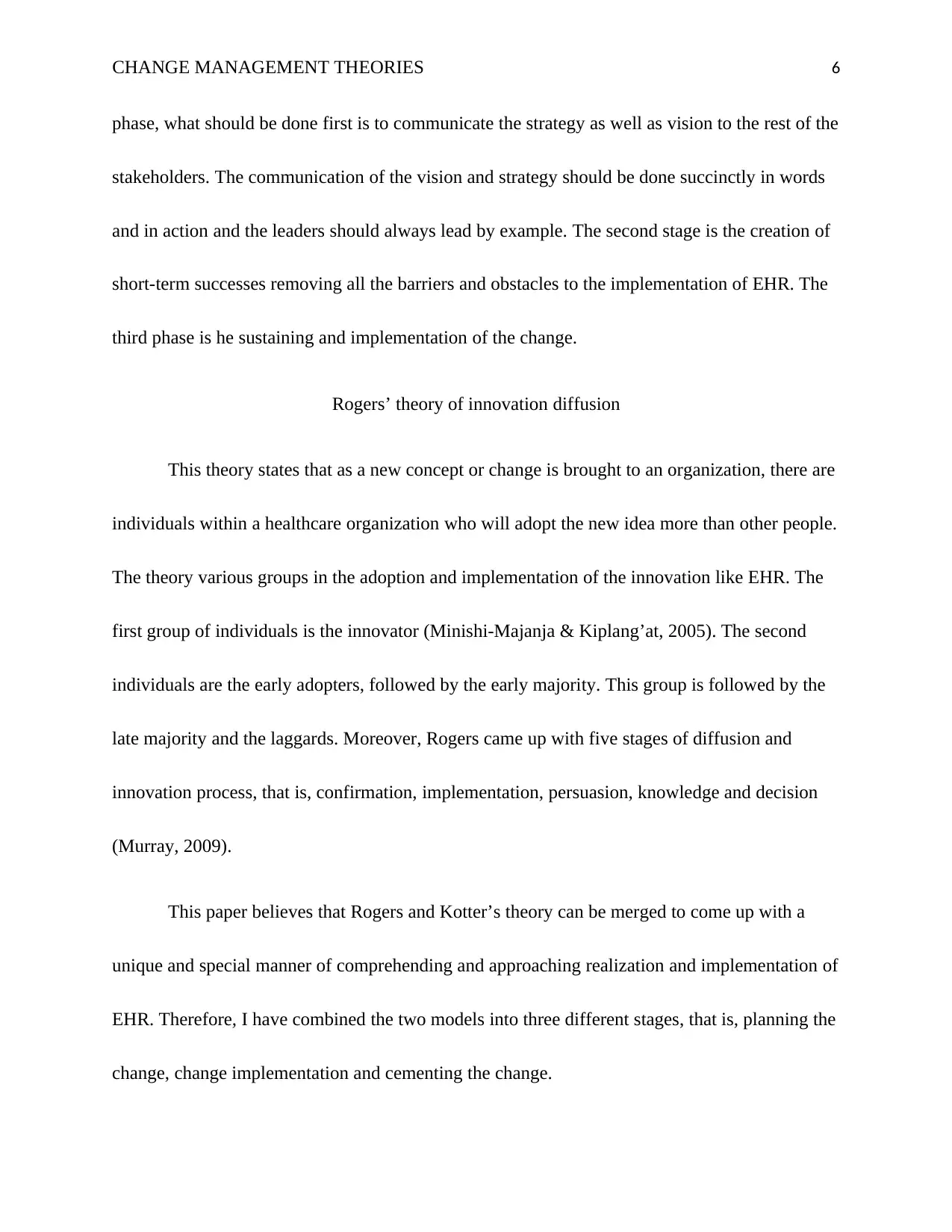
CHANGE MANAGEMENT THEORIES 6
phase, what should be done first is to communicate the strategy as well as vision to the rest of the
stakeholders. The communication of the vision and strategy should be done succinctly in words
and in action and the leaders should always lead by example. The second stage is the creation of
short-term successes removing all the barriers and obstacles to the implementation of EHR. The
third phase is he sustaining and implementation of the change.
Rogers’ theory of innovation diffusion
This theory states that as a new concept or change is brought to an organization, there are
individuals within a healthcare organization who will adopt the new idea more than other people.
The theory various groups in the adoption and implementation of the innovation like EHR. The
first group of individuals is the innovator (Minishi-Majanja & Kiplang’at, 2005). The second
individuals are the early adopters, followed by the early majority. This group is followed by the
late majority and the laggards. Moreover, Rogers came up with five stages of diffusion and
innovation process, that is, confirmation, implementation, persuasion, knowledge and decision
(Murray, 2009).
This paper believes that Rogers and Kotter’s theory can be merged to come up with a
unique and special manner of comprehending and approaching realization and implementation of
EHR. Therefore, I have combined the two models into three different stages, that is, planning the
change, change implementation and cementing the change.
phase, what should be done first is to communicate the strategy as well as vision to the rest of the
stakeholders. The communication of the vision and strategy should be done succinctly in words
and in action and the leaders should always lead by example. The second stage is the creation of
short-term successes removing all the barriers and obstacles to the implementation of EHR. The
third phase is he sustaining and implementation of the change.
Rogers’ theory of innovation diffusion
This theory states that as a new concept or change is brought to an organization, there are
individuals within a healthcare organization who will adopt the new idea more than other people.
The theory various groups in the adoption and implementation of the innovation like EHR. The
first group of individuals is the innovator (Minishi-Majanja & Kiplang’at, 2005). The second
individuals are the early adopters, followed by the early majority. This group is followed by the
late majority and the laggards. Moreover, Rogers came up with five stages of diffusion and
innovation process, that is, confirmation, implementation, persuasion, knowledge and decision
(Murray, 2009).
This paper believes that Rogers and Kotter’s theory can be merged to come up with a
unique and special manner of comprehending and approaching realization and implementation of
EHR. Therefore, I have combined the two models into three different stages, that is, planning the
change, change implementation and cementing the change.
⊘ This is a preview!⊘
Do you want full access?
Subscribe today to unlock all pages.

Trusted by 1+ million students worldwide
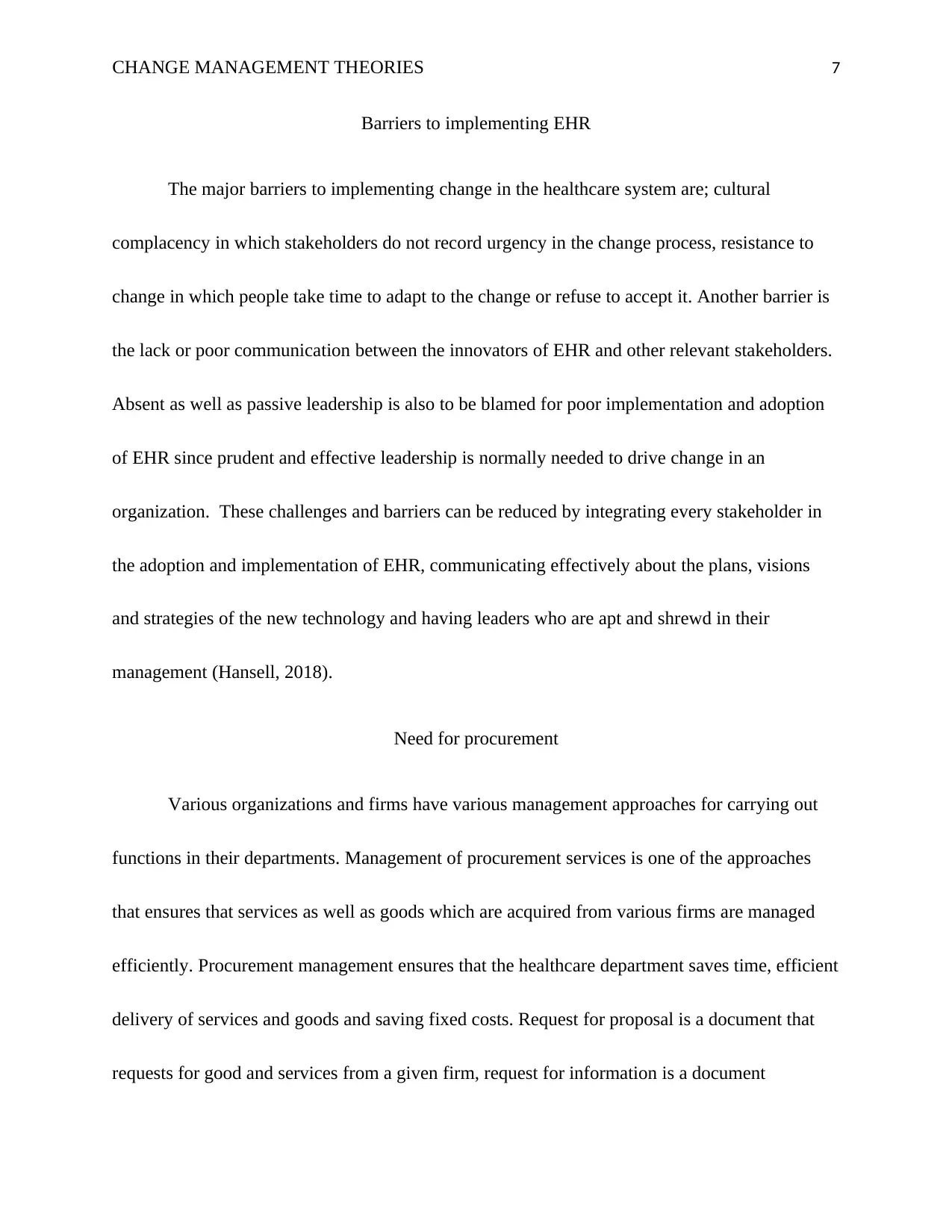
CHANGE MANAGEMENT THEORIES 7
Barriers to implementing EHR
The major barriers to implementing change in the healthcare system are; cultural
complacency in which stakeholders do not record urgency in the change process, resistance to
change in which people take time to adapt to the change or refuse to accept it. Another barrier is
the lack or poor communication between the innovators of EHR and other relevant stakeholders.
Absent as well as passive leadership is also to be blamed for poor implementation and adoption
of EHR since prudent and effective leadership is normally needed to drive change in an
organization. These challenges and barriers can be reduced by integrating every stakeholder in
the adoption and implementation of EHR, communicating effectively about the plans, visions
and strategies of the new technology and having leaders who are apt and shrewd in their
management (Hansell, 2018).
Need for procurement
Various organizations and firms have various management approaches for carrying out
functions in their departments. Management of procurement services is one of the approaches
that ensures that services as well as goods which are acquired from various firms are managed
efficiently. Procurement management ensures that the healthcare department saves time, efficient
delivery of services and goods and saving fixed costs. Request for proposal is a document that
requests for good and services from a given firm, request for information is a document
Barriers to implementing EHR
The major barriers to implementing change in the healthcare system are; cultural
complacency in which stakeholders do not record urgency in the change process, resistance to
change in which people take time to adapt to the change or refuse to accept it. Another barrier is
the lack or poor communication between the innovators of EHR and other relevant stakeholders.
Absent as well as passive leadership is also to be blamed for poor implementation and adoption
of EHR since prudent and effective leadership is normally needed to drive change in an
organization. These challenges and barriers can be reduced by integrating every stakeholder in
the adoption and implementation of EHR, communicating effectively about the plans, visions
and strategies of the new technology and having leaders who are apt and shrewd in their
management (Hansell, 2018).
Need for procurement
Various organizations and firms have various management approaches for carrying out
functions in their departments. Management of procurement services is one of the approaches
that ensures that services as well as goods which are acquired from various firms are managed
efficiently. Procurement management ensures that the healthcare department saves time, efficient
delivery of services and goods and saving fixed costs. Request for proposal is a document that
requests for good and services from a given firm, request for information is a document
Paraphrase This Document
Need a fresh take? Get an instant paraphrase of this document with our AI Paraphraser
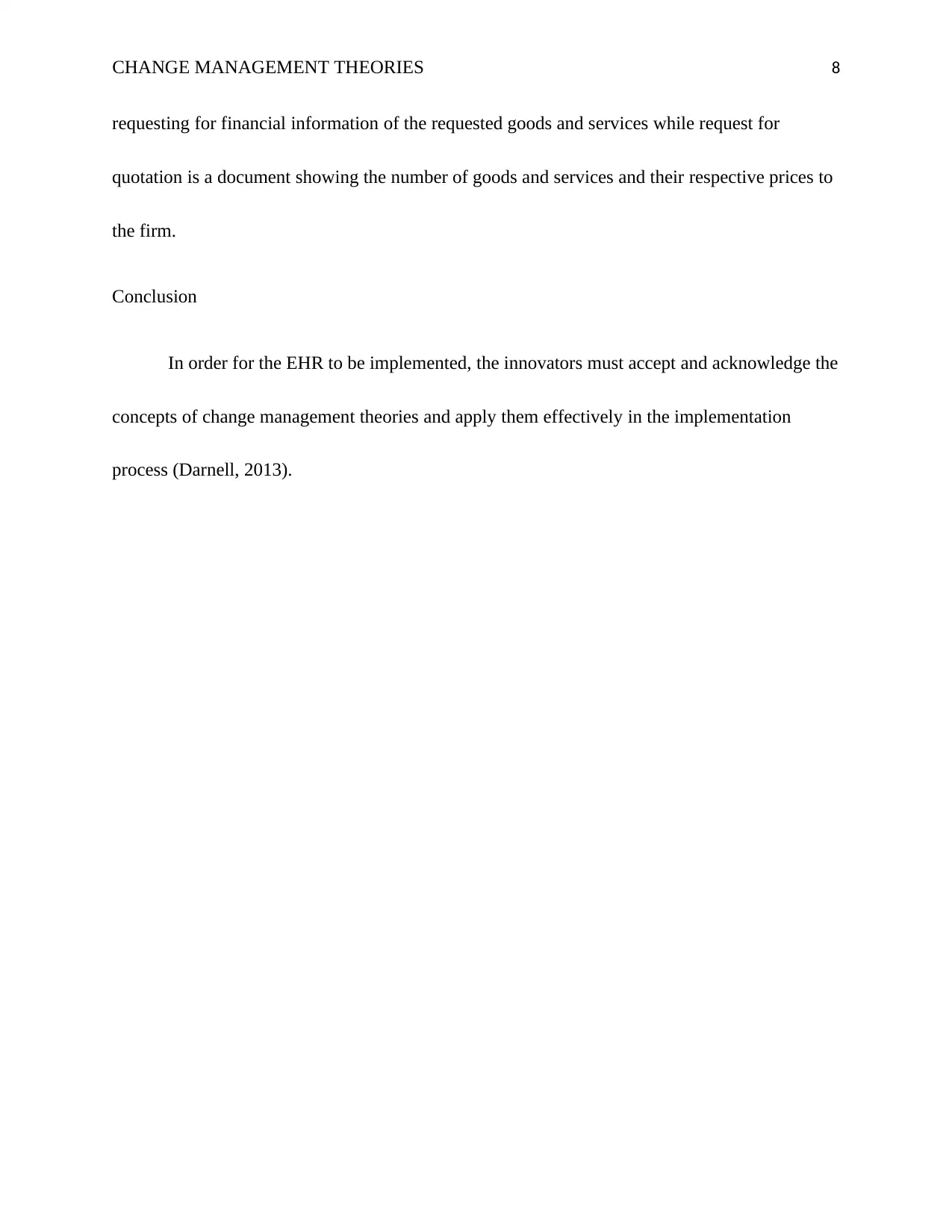
CHANGE MANAGEMENT THEORIES 8
requesting for financial information of the requested goods and services while request for
quotation is a document showing the number of goods and services and their respective prices to
the firm.
Conclusion
In order for the EHR to be implemented, the innovators must accept and acknowledge the
concepts of change management theories and apply them effectively in the implementation
process (Darnell, 2013).
requesting for financial information of the requested goods and services while request for
quotation is a document showing the number of goods and services and their respective prices to
the firm.
Conclusion
In order for the EHR to be implemented, the innovators must accept and acknowledge the
concepts of change management theories and apply them effectively in the implementation
process (Darnell, 2013).
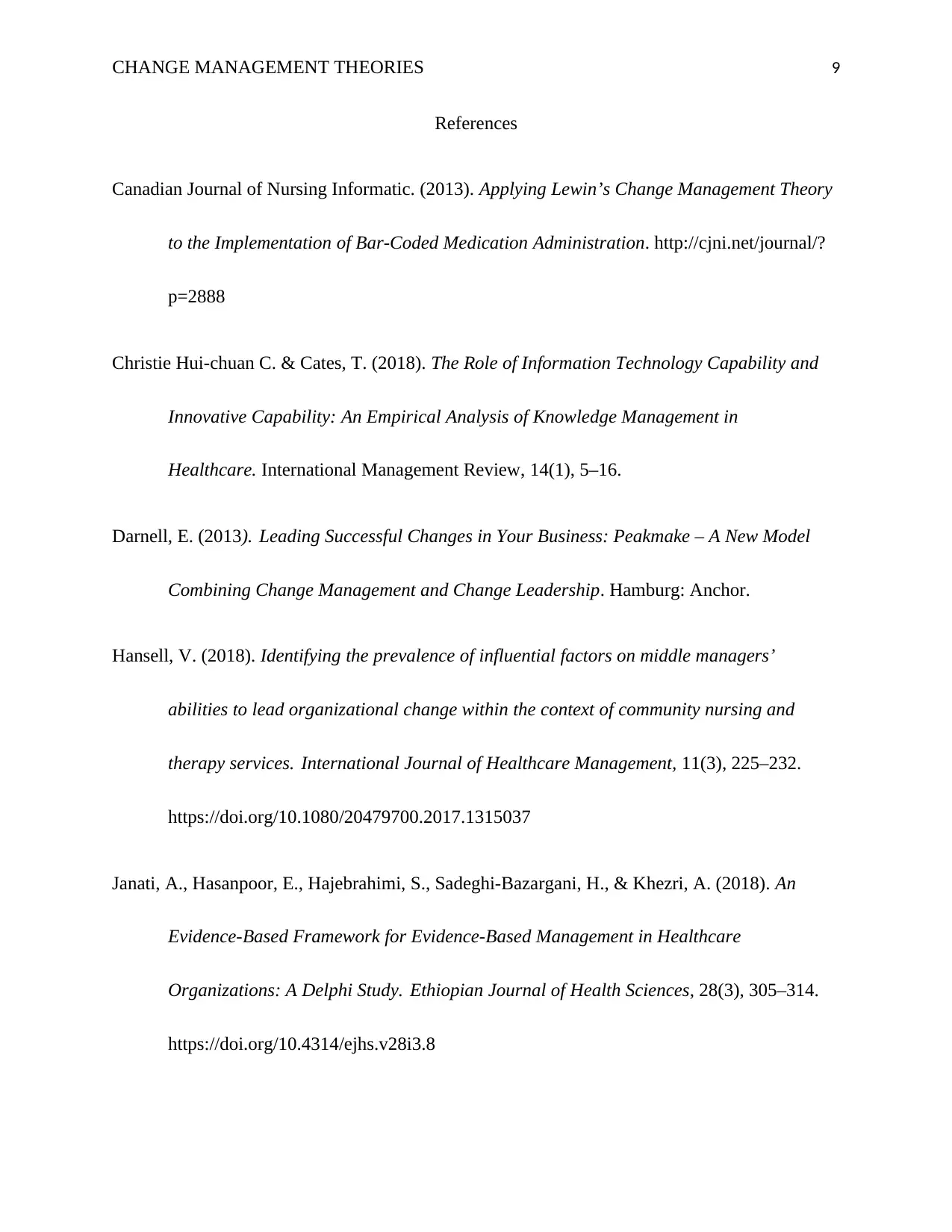
CHANGE MANAGEMENT THEORIES 9
References
Canadian Journal of Nursing Informatic. (2013). Applying Lewin’s Change Management Theory
to the Implementation of Bar-Coded Medication Administration. http://cjni.net/journal/?
p=2888
Christie Hui-chuan C. & Cates, T. (2018). The Role of Information Technology Capability and
Innovative Capability: An Empirical Analysis of Knowledge Management in
Healthcare. International Management Review, 14(1), 5–16.
Darnell, E. (2013). Leading Successful Changes in Your Business: Peakmake – A New Model
Combining Change Management and Change Leadership. Hamburg: Anchor.
Hansell, V. (2018). Identifying the prevalence of influential factors on middle managers’
abilities to lead organizational change within the context of community nursing and
therapy services. International Journal of Healthcare Management, 11(3), 225–232.
https://doi.org/10.1080/20479700.2017.1315037
Janati, A., Hasanpoor, E., Hajebrahimi, S., Sadeghi-Bazargani, H., & Khezri, A. (2018). An
Evidence-Based Framework for Evidence-Based Management in Healthcare
Organizations: A Delphi Study. Ethiopian Journal of Health Sciences, 28(3), 305–314.
https://doi.org/10.4314/ejhs.v28i3.8
References
Canadian Journal of Nursing Informatic. (2013). Applying Lewin’s Change Management Theory
to the Implementation of Bar-Coded Medication Administration. http://cjni.net/journal/?
p=2888
Christie Hui-chuan C. & Cates, T. (2018). The Role of Information Technology Capability and
Innovative Capability: An Empirical Analysis of Knowledge Management in
Healthcare. International Management Review, 14(1), 5–16.
Darnell, E. (2013). Leading Successful Changes in Your Business: Peakmake – A New Model
Combining Change Management and Change Leadership. Hamburg: Anchor.
Hansell, V. (2018). Identifying the prevalence of influential factors on middle managers’
abilities to lead organizational change within the context of community nursing and
therapy services. International Journal of Healthcare Management, 11(3), 225–232.
https://doi.org/10.1080/20479700.2017.1315037
Janati, A., Hasanpoor, E., Hajebrahimi, S., Sadeghi-Bazargani, H., & Khezri, A. (2018). An
Evidence-Based Framework for Evidence-Based Management in Healthcare
Organizations: A Delphi Study. Ethiopian Journal of Health Sciences, 28(3), 305–314.
https://doi.org/10.4314/ejhs.v28i3.8
⊘ This is a preview!⊘
Do you want full access?
Subscribe today to unlock all pages.

Trusted by 1+ million students worldwide
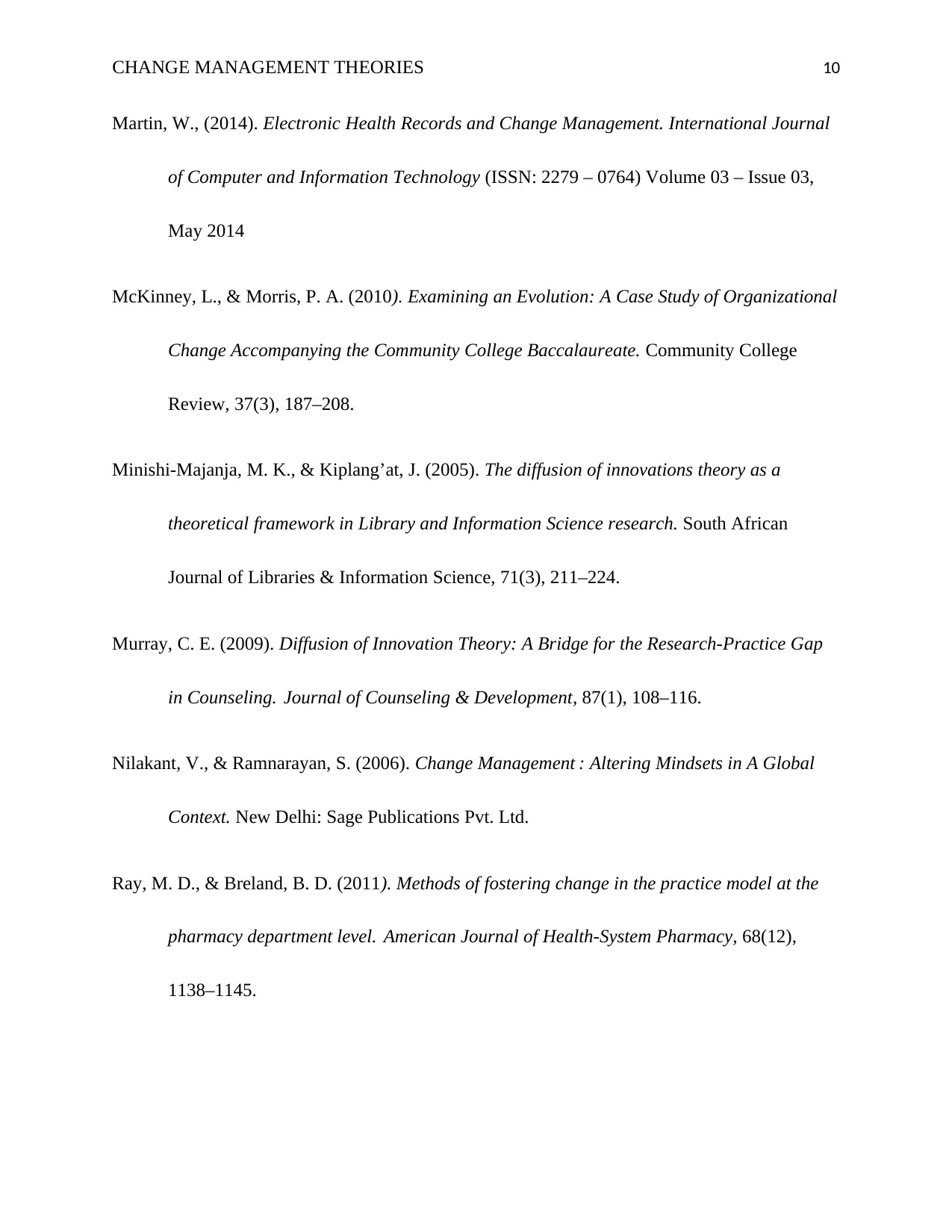
CHANGE MANAGEMENT THEORIES 10
Martin, W., (2014). Electronic Health Records and Change Management. International Journal
of Computer and Information Technology (ISSN: 2279 – 0764) Volume 03 – Issue 03,
May 2014
McKinney, L., & Morris, P. A. (2010). Examining an Evolution: A Case Study of Organizational
Change Accompanying the Community College Baccalaureate. Community College
Review, 37(3), 187–208.
Minishi-Majanja, M. K., & Kiplang’at, J. (2005). The diffusion of innovations theory as a
theoretical framework in Library and Information Science research. South African
Journal of Libraries & Information Science, 71(3), 211–224.
Murray, C. E. (2009). Diffusion of Innovation Theory: A Bridge for the Research-Practice Gap
in Counseling. Journal of Counseling & Development, 87(1), 108–116.
Nilakant, V., & Ramnarayan, S. (2006). Change Management : Altering Mindsets in A Global
Context. New Delhi: Sage Publications Pvt. Ltd.
Ray, M. D., & Breland, B. D. (2011). Methods of fostering change in the practice model at the
pharmacy department level. American Journal of Health-System Pharmacy, 68(12),
1138–1145.
Martin, W., (2014). Electronic Health Records and Change Management. International Journal
of Computer and Information Technology (ISSN: 2279 – 0764) Volume 03 – Issue 03,
May 2014
McKinney, L., & Morris, P. A. (2010). Examining an Evolution: A Case Study of Organizational
Change Accompanying the Community College Baccalaureate. Community College
Review, 37(3), 187–208.
Minishi-Majanja, M. K., & Kiplang’at, J. (2005). The diffusion of innovations theory as a
theoretical framework in Library and Information Science research. South African
Journal of Libraries & Information Science, 71(3), 211–224.
Murray, C. E. (2009). Diffusion of Innovation Theory: A Bridge for the Research-Practice Gap
in Counseling. Journal of Counseling & Development, 87(1), 108–116.
Nilakant, V., & Ramnarayan, S. (2006). Change Management : Altering Mindsets in A Global
Context. New Delhi: Sage Publications Pvt. Ltd.
Ray, M. D., & Breland, B. D. (2011). Methods of fostering change in the practice model at the
pharmacy department level. American Journal of Health-System Pharmacy, 68(12),
1138–1145.
1 out of 10
Related Documents
Your All-in-One AI-Powered Toolkit for Academic Success.
+13062052269
info@desklib.com
Available 24*7 on WhatsApp / Email
![[object Object]](/_next/static/media/star-bottom.7253800d.svg)
Unlock your academic potential
Copyright © 2020–2025 A2Z Services. All Rights Reserved. Developed and managed by ZUCOL.




